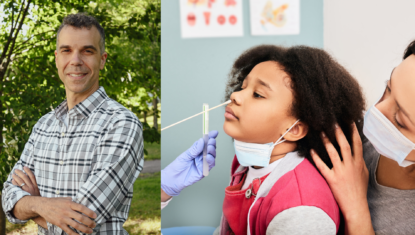03/08/2022
Ottawa, Ontario — Wednesday August 3, 2022

More than two years into the COVID-19 pandemic, most of us have been subjected to the long swab up the nose to test for SARS-CoV-2 (COVID-19) infection. For kids, this “booger tickler” known as the deep nasopharyngeal swab can be quite the unpleasant experience, but it is the current gold standard for COVID-19 polymerase chain reaction (PCR) testing.
Saliva sampling is a proposed alternative for COVID-19 testing, but acceptability data is lacking. François Gagnon, a recent graduate of the CHEO Emergency Department physician training program, was supervised by CHEO Research Institute Investigator and ED physician Stuart Harman in carrying out a first-of-its-kind survey to ask children and caregivers, who had experience with both forms of testing methods, to rate the acceptability of each.
“Not surprising, most children found the nasopharyngeal swabs painful and prefer saliva swabs. Caregivers, however, remain highly accepting of both testing methods, though acceptability of the more painful method varies when the reason for testing changes and is influenced by perceived test accuracy. Interestingly, most caregivers were willing to trade some test comfort for kids if it meant an improvement in test accuracy,” said Harman, who is also an Assistant Professor at the University of Ottawa Faculty of Medicine.
The study administered a cross-sectional survey to participants aged six to 17 years and their primary decision makers at an Ottawa community COVID-19 testing centre in March 2021. Included were participants meeting local guidelines for testing. Excluded were those identified prior to participation as having inability to complete the consent, sampling, or survey process.
Key findings:
- About 60% of children found the nasopharyngeal swab to be significantly painful (rating pain as four or higher on a scale out of 10), and the vast majority prefer saliva sampling (which was deemed virtually painless).
- Caregivers/primary decision makers were highly likely to accept testing again if recommended in the future, with either nasopharyngeal swabbing or saliva sampling, though acceptability of nasopharyngeal swabs changed in different scenarios with different reasons for testing.
- Most caregivers, after seeing their child receive both testing methods, would choose the more uncomfortable nasopharyngeal swab over the painless saliva sample if it was true that the saliva sample was 10% less sensitive.
“COVID-19 testing is with us for the foreseeable future as we continue to navigate the many waves of this pandemic. Understanding factors that influence testing acceptance will help inform more successful testing strategies for kids and youth not only during this pandemic, but in future pandemics as well,” added Harman.
Media contact:
Jennifer Ruff
Manager of Communications
(613) 261-3979
[email protected]
